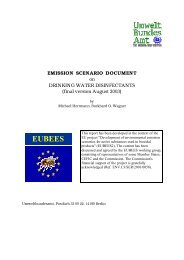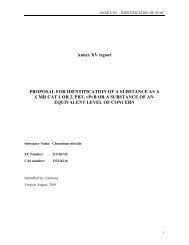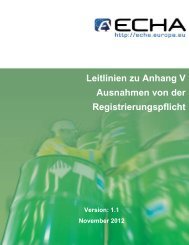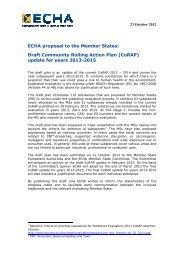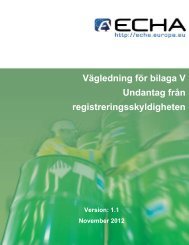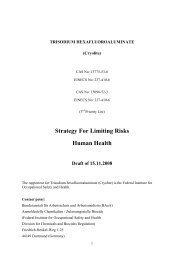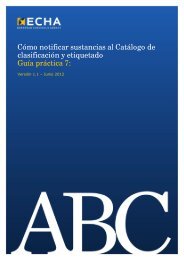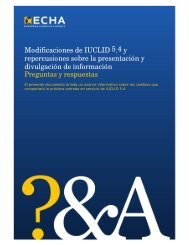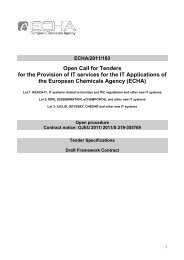Practical Guide 5: How to report (Q)SARs - ECHA - Europa
Practical Guide 5: How to report (Q)SARs - ECHA - Europa
Practical Guide 5: How to report (Q)SARs - ECHA - Europa
You also want an ePaper? Increase the reach of your titles
YUMPU automatically turns print PDFs into web optimized ePapers that Google loves.
− the field “Principles of method other than guideline” is used <strong>to</strong> include the name<br />
of the model.<br />
Block “Test materials”<br />
− select “yes” in the drop down menu "Test material same as for substance defined<br />
in section 1 (if not read across)”, if the (Q)SAR model is applied <strong>to</strong> the substance<br />
as <strong>report</strong>ed in section 1.1 of the IUCLID 5 dossier. If the (Q)SAR prediction refers<br />
<strong>to</strong> one constituent of the substance, select “no” and indicate the identity of the<br />
constituent in the “Test material identity”<br />
− the field “Test material identity” is used <strong>to</strong> include information on the substance<br />
for which the prediction was made. Please note, that the substance for which the<br />
registration is being made may contain more than one constituent. Each<br />
individual constituent for which the prediction is made should be listed in this<br />
field. Please note that it may be useful <strong>to</strong> prepare in such cases an individual<br />
endpoint study record for each constituent in order <strong>to</strong> be able <strong>to</strong> address each<br />
chemical separately (recommended if constituents have different properties and<br />
different models, assessments, etc have <strong>to</strong> be applied).<br />
− the field “Details on test material” is used <strong>to</strong> include the structural representation<br />
(e.g. SMILES notation, mol file as attachment etc.) and possible descrip<strong>to</strong>r values<br />
if used and as used <strong>to</strong> derive the prediction. If the substance contains impurities<br />
for which a prediction is made, the chemical identification should be <strong>report</strong>ed in<br />
the “Details on the test material”, including the structural representation or<br />
possible descrip<strong>to</strong>r values used. As for constituents, the generation of an<br />
individual endpoint study record for an impurity can be useful, particularly when<br />
different models, assessments, etc have <strong>to</strong> be applied because of different<br />
chemical properties.<br />
− Confidential information can be placed in “Confidential details on test material”.<br />
8






